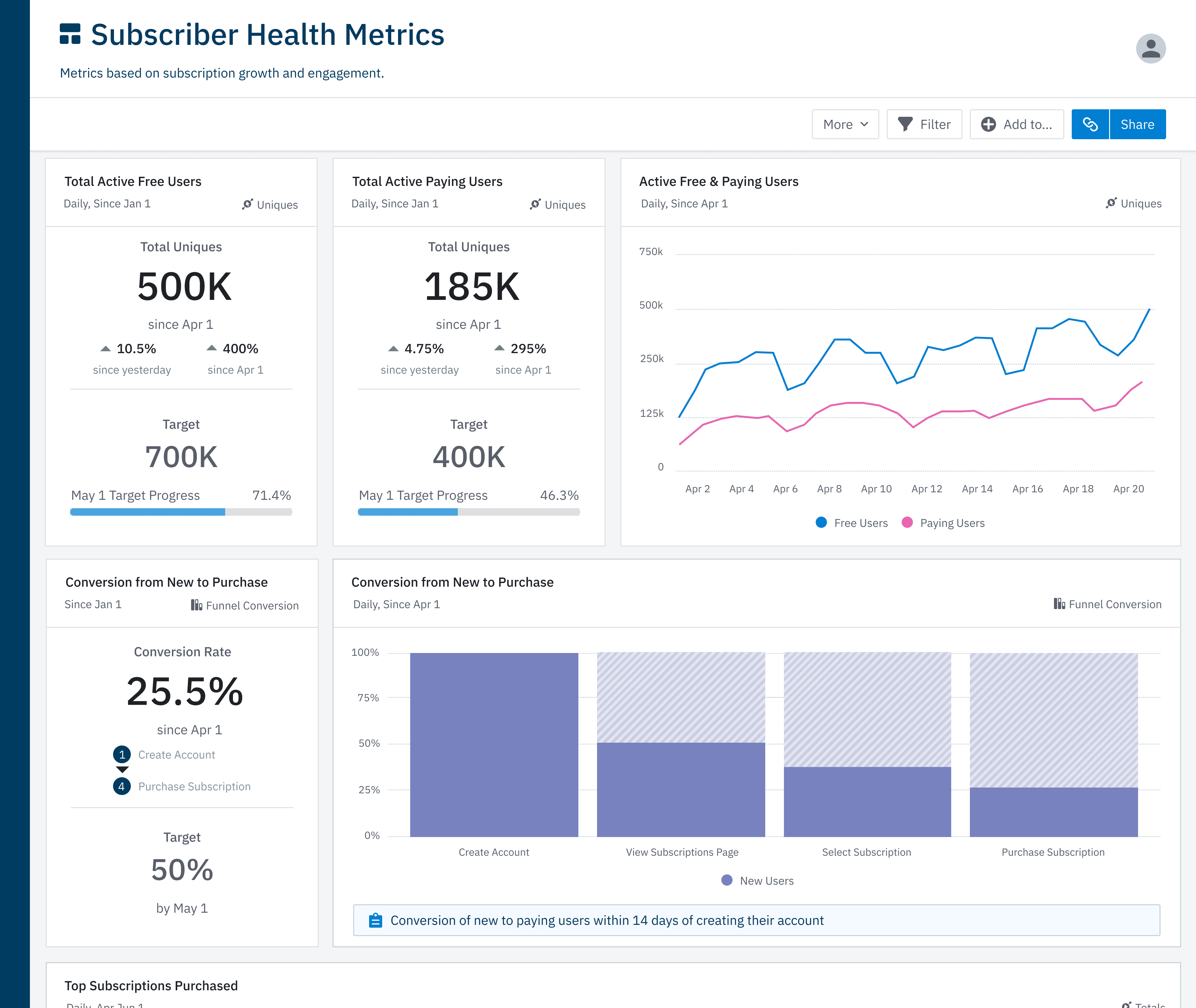How to Monitor Digital Business Performance with New Executive Reporting
We reinvented the dashboard for the new digital executive. Go beyond legacy KPIs and measure the metrics that matter.
Today, we’re announcing new Executive Reporting, a series of powerful upgrades to our Dashboards that help leaders monitor digital business performance. Customers can now set and track progress to a target metric, add critical context as notes throughout the Dashboard, and more flexibly customize the layout of any report.

Over the past several years, we’ve seen the rapid emergence of the product-led digital leader. More and more, companies are recognizing that the success of their digital products drive their digital business, and executives are recognizing the importance of connecting business performance to product and customer data. Keeping a pulse on metrics across the customer journey like new user retention and optimizing key product funnels has become essential to growing the business.
Why Legacy Dashboards and KPIs Aren’t Enough
According to the executives surveyed in a new report by Harvard Business Review, where digital leaders once measured success against customer awareness, NPS, and acquisition goals, they now cite user engagement, customer retention rate, and customer lifetime value as their top indicators of success. They set goals and track against them in real-time–and they want to dig into how the bets the product and marketing teams are making are impacting these key digital metrics.
Tracking impressions, website visitors, and surface-level growth numbers in static dashboards no longer suffices as adequate indicators of business health and product success. And executives don’t have time to wait days or weeks to get their question answered on a new cut of the data. As per a report by Gartner’s Sr. Director Analyst Joseph Enever and VP Analyst Lizzy Foo Kune:
“Gartner’s clients continue to express strong interest in designing useful dashboards. Their frustration is clear — they find their current dashboards heavy on numbers and charts, but light on powerful decision support.” According to the report one of the key challenges is that, “Users complain that their dashboards contain a lot of information that’s interesting, but that doesn’t help them make decisions.” It is further mentioned that, “Interactivity is also desirable, if it allows the user to drill down into detail on a specific, higher-level metric.”
The success of digital businesses is centered on optimizing value where customers spend most of their time–the digital product–and a team’s ability to make impactful decisions faster. And that’s why we built a new type of dashboard, built for the digital-first, product-led business leader.
Becoming Your Source for Digital Business Performance with Executive Reporting
As this shift has taken place, our customers have increasingly looked to monitor and track changes against product performance via Amplitude. In Amplitude, critical product metrics such as subscriber retention and free-to-paid conversion can be forecasted and monitored in real-time, and consumers of that data can easily add their own filters to the reporting without the help of an analyst. While a request to add a “region” or “business unit” filter to a report may have taken two weeks with a business intelligence tool, applying new filters is available self-serve on Amplitude Dashboards.

And now, with a series of upgrades to both our Dashboard and Notebook features, our new Executive Reporting makes Amplitude a source of truth for measuring digital business performance. With better shared insight into what customer behaviors drive business outcomes, teams across the organization can now optimize every part of their digital product experiences to maximize growth.
“Organizational alignment is essential – Amplitude Analytics gives us a shared version of truth and enables orgs to work together. We’re looking at the same data for the first time. It’s our single source of what’s going on in the products.”
—Nilanjan Adhya, Chief Digital Officer at IBM
With the addition of target metrics, better organization and visibility of key charts, and the ability to add critical context to each insight, our Dashboards become the hub for monitoring digital performance. Leaders can easily:
- Report on product health
- Track against targets
- Monitor performance changes over time
- Drill into critical insights wherever they need them

Start Monitoring Metrics that Matter
These enhancements are live now. Check out the new Executive Reporting in a demo account, or log into your account to customize Dashboards.
Here are a few ways to get started:
- Add one, two, three, or up to four charts on the same row, and as many as you want on the page overall.
- Add a note to any visualization to give your team context on what they should know while consuming your Dashboard, or make a note of how an important metric is defined.
- Apply property and date filters to Dashboards and see updates in seconds.
- Set a target to motivate the team and inform consumers on how you’re tracking to your goal. Target metrics are supported on key chart types such as Event Segmentation, Funnels, and Sessions.
To learn more, demo the new Executive Reporting Dashboards or schedule a call with our team today.

Abbie Kouzmanoff
Former Senior Product Manager, Amplitude
Abbie is a former senior product manager at Amplitude, focusing on helping companies adopt product intelligence to ultimately build better products. She was previously a product manager at Dropbox where she drove revenue growth for the company through continuous experimentation and optimization.
More from Abbie




